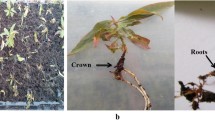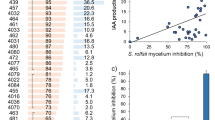Abstract
Previous studies demonstrated that the Chryseobacterium sp. WR21 could effectively control the bacterial wilt disease caused by Ralstonia solanacearum through effective root colonization. The strain WR21 exhibited a low level of DNA homology with Chryseobacterium strains DSM 15235T (24.1%), DSM 17724T (24.8%), and DSM 18014T (10.4%), suggesting that WR21 may represent a novel species, for which the name Chryseobacterium nankingense sp. nov. is proposed. The in vitro competition experiments with strain WR21 indicated it significantly inhibited growth of the pathogen in co-culture with six of nine tested nutrients (e.g. root exudates) that could be utilized by strain WR21 and R. solanacearum. Similar trends were observed in co-culturing experiments using tissue exudates of tomato. A positive relationship (r = 0.785) was noticed between the differences in the average growth rate of both strains and the disease suppression effects. In conclusion, Chryseobacterium nankingense sp. nov. WR21 exhibits antagonism through nutrient competition that might be used for achieving biocontrol of Ralstonia solanacearum induced wilts.



Similar content being viewed by others
References
Bernardet JF, Vancanneyt M, Matte-Tailliez O, Grisez L, Tailliez P, Bizete C, Nowakowskie M, Kerouaulta B, Swings J (2005) Polyphasic study of Chryseobacterium strains isolated from diseased aquatic animals. Syst Appl Microbiol 28:640–660
Compant S, Clément C, Sessitsch A (2010) Plant growth-promoting bacteria in the rhizo- and endosphere of plants: their role, colonization, mechanisms involved and prospects for utilization. Soil Biol Biochem 42:669–678
Dessaux Y, Grandclément C, Faure D (2016) Engineering the rhizosphere. Trends Plant Sci 21(3):266–278
Euzéby JP (1997) List of bacterial names with standing in nomenclature a folder available on the internet. Int J Syst Bact 47:590–592
Francis I, Holsters M, Vereecke D (2010) The gram-positive side of plant-microbe interactions. Environ Microbiol 12:1–12
Friginal J, Andrés D, Ruiz JC, Martínez M (2014) A survey of evaluation platforms for ad hoc routing protocols: a resilience perspective. Comput Netw 75:395–413
Gamliel A, Katan J (1992) Chemotaxis of fluorescent pseudomonads towards seed exudates and germinating seeds in solarized soil. Ecol Epidemiol 82:328–332
Haichar FeZ, Santaella C, Heulin T, Achouak W (2014) Root exudates mediated interactions belowground. Soil Biol Biochem 77:69–80
Hayward AC (1991) Biology and epidemiology of bacterial wilt caused by Pseudomonas solanacearum. Ann Rev Phytopathol 29:65–87
Helal HM, Sauerbeck D (1986) Effect of plant roots on carbon metabolism of soil microbial biomass. Zeitschrift für Pflanzenernährung und Bodenkunde 149:181–188
Huang JF, Wei Z, Tan SY, Mei XL, Yin SX, Shen QR, Xu YC (2013) The rhizosphere soil of diseased tomato plants as a source for novel microorganisms to control bacterial wilt. Appl Soil Ecol 72:79–84
Huss VAR, Festl H, Schleifer KH (1983) Studies on the spectrophotometric determination of DNA hybridization from renaturation rates. Syst Appl Microbiol 4:184–192
Jones DL, Hodge A, Kuzyakov Y (2004) Plant and mycorrhizal regulation of rhizodeposition. New Phytol 163:459–480
Kamilova F, Validov S, Azarova T, Mulders I, Lugtenberg B (2005) Enrichment for enhanced competitive plant root tip colonizers selects for a new class of biocontrol bacteria. Environ Microbiol 7:1809–1817
Kheirandish Z, Harighi B (2015) Evaluation of bacterial antagonists of Ralstonia solanacearum, causal agent of bacterial wilt of potato. Biol Control 86:14–19
Kim OS, Cho YJ, Lee K, Yoon SH, Kim M, Na H, Park SC, Jeon YS, Lee JH, Yi H, Won S, Chun J (2012) Introducing EzTaxon-e: a prokaryotic 16S rRNA Gene sequence database with phylotypes that represent uncultured species. Int J Syst Evol Microbiol 62:716–721
Ley JD, Cattoir H, Reynaerts A (1970) The quantitative measurement of DNA hybridization from renaturation rates. Eur J Biochem 12:133–142
Ling N, Xue C, Huang QW, Yang XM, Xu YC, Shen QR (2010) Development of a mode of application of bioorganic fertilizer for improving the biocontrol efficacy to Fusarium wilt. BioControl 55:673–683
Lugtenberg B, Kamilova F (2009) Plant-growth-promoting rhizobacteria. Ann Rev Microbiol 63:541–556
McCarthy AJ, Cross T (1984) A taxonomic study of Thermomonospora and other monosporic actinomycetes. J Gen Microbiol 130:5–25
Oksinska MP, Wright SAI, Pietr SJ (2011) Colonization of wheat seedlings (Triticum aestivum L.) by strains of Pseudomonas spp. with respect to their nutrient utilization profiles. Eur J Soil Biol 47:364–373
Pérez-García A, Romero D, Vicente Ad (2011) Plant protection and growth stimulation by microorganisms: biotechnological applications of Bacilli in agriculture. Curr Opin Biotech 22:187–193
Raaijmakers JM, Paulitz TC, Steinberg C, Alabouvette C, Moënne-Loccoz Y (2008) The rhizosphere: a playground and battlefield for soilborne pathogens and beneficial microorganisms. Plant Soil 321:341–361
Riaz K, Elmerich C, Raffoux A, Moreira D, Dessaux Y, Faure D (2008) A metagenomic analysis of soil bacteria extends the diversity of quorum-quenching lactonases. Environ Microbiol 10(3):560–570
Rudrappa T, Bais HP (2008) Rhizospheric pseudomonads: friends or foes? Plant Signal Behav 3:1132–1133
Schnider-Keel U, Seematter A, Maurhofer M, Blumer C, Duffy B, Gigot-Bonnefoy C, Reimmann C, Notz R, Défago G, Haas D, Keel C (2000) Autoinduction of 2,4-Diacetylphloroglucinol biosynthesis in the biocontrol agent Pseudomonas fluorescens CHA0 and repression by the bacterial metabolites salicylate and pyoluteorin. J Bacteriol 182(5):1215–1225
Shiomi Y, Nishiyama M, Onizuka T, Marumoto T (1999) Comparison of bacterial community structures in the rhizoplane of tomato plants grown in soils suppressive and conducive towards bacterial wilt. Appl Environ Microbiol 65:3996–4001
Smibert RM, Krieg NR (1994) Phenotypic characterization. In: Gerhardt P, Murray RGE, Wood WA, Krieg NR (eds) Methods for general and molecular bacteriology. American Society for Microbiology, Washington, DC, pp 607–654
Tamura K, Stecher G, Peterson D, Filipski A, Kumar S (2013) MEGA6: molecular evolutionary genetics analysis version 6.0. Mol Bio Evol 30:2725–2729
Tan SY, Jiang Y, Song S, Huang JF, Ling N, Xu YC, Shen QR (2013) Two Bacillus amyloliquefaciens strains isolated using the competitive tomato root enrichment method and their effects on suppressing Ralstonia solanacearum and promoting tomato plant growth. Crop Prot 43:134–140
Tan SY, Gu YA, Yang CL, Dong Y, Mei XL, Shen QR, Xu YC (2016) Bacillus amyloliquefaciens T-5 may prevent Ralstonia solanacearum infection through competitive exclusion. Biol Fertil Soils 52:341–351
Vandamme P, Bernardet JF, Segers P, Kersters K, Holmes B (1994) New perspectives in the classification of the Flavobacteria: description of Chryseobacterium gen. nov., Bergeyella gen. nov., and Empedobacter nom. rev. Int J Syst Bacteriol 44:827–831
Wang SL, Yang CH, Liang TW, Yen YH (2008) Optimization of conditions for protease production by Chryseobacterium taeanense TKU001. Bioresour Technol 99:3700–3707
Weger LAD, Vlugt CMVD, Wijfjes AHM, Bakker PAHM, Schippers B, Lugtenberg B (1987) Flagella of a plant-growth-stimulating Pseudomonas fluorescens strain are required for colonization of potato roots. J Bacteriol 169:2769–2773
Wei Z, Yang XM, Yin SX, Shen QR, Xu YC (2011) Efficacy of Bacillus-fortified organic fertiliser in controlling bacterial wilt of tomato in the field. Appl Soil Ecol 48:152–159
Wei Z, Yang TJ, Friman VP, Xu YC, Shen QR, Jousset A (2015) Trophic network architecture of root-associated bacterial communities determines pathogen invasion and plant health. Nat Commun 6:1–9
Weller D (1988) Biological control of soilborne plant pathogens in the rhizosphere with bacteria. Annu Rev Phytopathol 26:379–407
Xue QY, Chen Y, Li SM, Chen LF, Ding GC, Guo DW, Guo JH (2009) Evaluation of the strains of Acinetobacter and Enterobacter as potential biocontrol agents against Ralstonia wilt of tomato. Biol Control 48:252–258
Ziegler M, Engel M, Welzl G, Schloter M (2013) Development of a simple root model to study the effects of single exudates on the development of bacterial community structure. J Microbiol Methods 94:30–36
Acknowledgements
We thank Prof. Shixue Yin from Yangzhou University and Dr. Jun Zhang from Nanjing Agricultural University for helpful assistance in the identification of Chryseobacterium nankingense strain WR21. We also are highly grateful to Prof. Dr. mark L Gleason for the correction of this manuscript. This research was financially supported by the National Natural Science Foundation of China (31501837 to Jianfeng Huang, 41471213 to Yangchun Xu, 41671248 and 41301262 to Zhong Wei), the National Key Basic Research Program of China (2015CB150503 to Qirong Shen), the Natural Science Foundation of Jiangsu Province (BK20130677 to Zhong Wei), the China Postdoctoral Science Foundation (2013M541687), the Young Elite Scientist Sponsorship Program by CAST (2015QNRC001 to Zhong Wei), and the Qing Lan Project (funding to Yangchun Xu and Zhong Wei).
Author information
Authors and Affiliations
Corresponding author
Additional information
Handling Editor: Fouad Daayf.
Electronic supplementary material
Below is the link to the electronic supplementary material.
Rights and permissions
About this article
Cite this article
Huang, J., Wei, Z., Hu, J. et al. Chryseobacterium nankingense sp. nov. WR21 effectively suppresses Ralstonia solanacearum growth via intensive root exudates competition. BioControl 62, 567–577 (2017). https://doi.org/10.1007/s10526-017-9812-1
Received:
Accepted:
Published:
Issue Date:
DOI: https://doi.org/10.1007/s10526-017-9812-1




